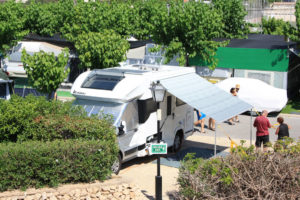Would you like to kit out your van as a campervan but you’re not sure how to begin? If you have a van and you don’t want to buy a caravan for your trips, the best option is to transform and adapt your van, making it a comfortable, safe space. Furthermore, if you’re something of a handyman, you’ll love the process and you’ll enjoy saving money.
If you have any concerns, relax. We’re offering you a complete guide detailing everything you need to consider to make your van feel like home. Read on!
What do I need to bear in mind when kitting out my van?
In order to achieve the comfort and security offered by a caravan, you need to consider a series of guidelines when kitting out your own van. Don’t worry about a thing, we’ve listed everything you need to know.
Estimate the cost
Before you begin, you should be clear about the approximate cost of kitting out your van so you can compare this with the price of buying a caravan and decide which is more economically viable.
In order to calculate the cost, you need to bear in mind the purchase of a van if you don’t have one, installation of thermal insulation, furnishings, installation of water and electricity circuits, ventilation, and all the accessories you want to include.
Choosing the best van
A good choice of van will help make the process of converting van for camping much easier. If you already have a van, you can skip this step as all you need to do is adapt it. If you are buying one, first of all you need to define your needs.
You must consider your budget and further costs. For this reason it’s important to choose a van that adapts to your money limit so there are no surprises.
It’s also important to know the number of travellers and the time the journey will take. The size of the van should vary depending on the people who must travel inside it and the time spent inside, given that the longer the trip, the more equipment you will need to take.
Installing thermal insulation
Insulating your van is one of the most important steps in the process of kitting it out for camping life. Using good insulation will prevent you from being cold in winter and hot in summer. By avoiding this change in temperature you will also prevent condensation and humidity.
There are many types of insulation materials. If you have a smaller budget, you can use mineral wool and reflective insulation, like those used in construction. Another option is polyurethane foam. Its quality is quite good but you need to know how to apply it and be careful with the door mechanisms. Finally, Kaiflex is a flexible, self-adhesive thermal insulation that is easy to cut and place, but it does cost more.
What are the best furnishings?
If you aren’t much of a handyman, there are pre-assembled furnishings you can use to furnish your van. All you need to know are the measurements of both to ensure they fit in perfectly.
Another option is to make them yourself. We recommend using thin, resistant, light panels. As such, you can maximise the space and make it more practical and comfortable when it comes to getting around with your van.
Installing water circuits
If you don’t need much hot water, two 25-litre decanters, a pump and a tap will be sufficient. In contrast, if you would like to use more than one apparatus with hot water, we recommend you use a system with two hot water and cold water circuits and a pressurised water pump. You will need to use a boiler to heat the water and this should have a thermostatic valve. This is a more complex process but it is very important if you want to shower with hot water.
Installing electrical circuits
There are many ways to do this. One way is to use an auxiliary or second battery that will provide general power for the different utensils and electrical appliances you will be using. You can also use a second electricity source if you install electrical appliances, you have lights inside, or you simply want to charge your mobile phone or laptop without using your vehicle’s battery. Finally, it’s a great idea to install solar panels.
Good ventilation
To prevent condensation from occurring, you should add an extra ventilation point. Even if you correctly insulate your vehicle it’s a good idea to have a ventilation point when it’s very hot outside.
Standardisation
Once you’ve prepared your campervan, it will need to undergo a new, extraordinary vehicle inspection (ITV in Spain). You will need to present the compliance report of your vehicle’s manufacturer, the kitting out project drawn up by an engineer, and the assembly certificate of the workshop where the work has been carried out.
If you have used anchoring systems that do not modify the van’s elements, it will simply need to pass an ordinary vehicle inspection.
Now you know how to kit out your van
Now you know everything you need to know to kit out your van for the camping lifestyle, it’s time to get to work. Here at Villasol Campsite we can’t wait to welcome you and give it the debut it deserves.





Leave a Reply